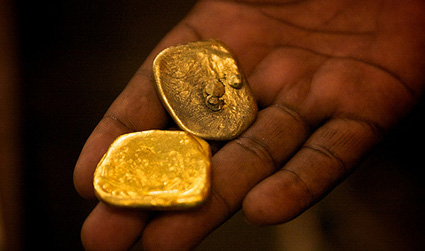
What is conflict gold?
The trade in conflict minerals—tin, tungsten, tantalum, and gold—is one of the primary drivers of violence in eastern Congo, where the world’s deadliest war rages. Conflict minerals fund armed groups, many of whom use mass rape and violence to secure control of mines and strategic trading routes.
Growing consumer pressure, U.S. legislation, and widespread industry action have all helped to reduce armed groups’ profits from tin, tungsten, and tantalum by approximately 65 percent, but armed groups still profit from the fourth conflict mineral—gold. Gold has emerged as the most lucrative conflict mineral because it is easy to smuggle small quantities for large profits. More than $600 million in gold is estimated to leave Congo annually, and fighting in and around gold mines continues, especially as armed groups allied with the M23 rebels attempt to take control of mines and trading routes.
What does the gold supply chain look like?
Conflict gold mined at one of the 15 major mines across eastern Congo follows six steps in a supply chain until it reaches its final form—gold bars or jewelry.
The conflict gold trade starts at mines controlled by armed groups in eastern Congo, where approximately 40 percent of the miners working in harsh and dangerous conditions are children. From there, gold is sold to smugglers, who illegally transport it to neighboring Uganda, Burundi, and Tanzania. The gold is then sent to Dubai, where it goes in one of two directions. Approximately half is processed at refineries, and the other half is made into jewelry for sale in the Middle East, China, and India. The processed gold is sold to banks in the form of gold bars or to jewelers around the world. So far, no jeweler or bank has been able to fully trace, audit, and certify that its gold is conflict-free.
What’s the solution?
Cleaning up the trade in conflict gold is essential to finding a lasting solution to the ongoing war. As the largest consumer of gold, jewelry companies should be part ofthe solution by proactively partnering with suppliers to source conflict-free gold from Congo. Similar mine-to-market projects have already been implemented by electronics companies in Congo. This type of investment by jewelry companies would help force armed groups out of the equation and return profits to the Congolese communities surrounding the mines—including providing safer jobs for local miners.
Beyond investment from jewelry companies, there is much more to be done. The Obama administration should take a leadership role in helping Congo and the region formalize the gold trade, making it more difficult for armed groups to smuggle and profit from conflict gold. In addition, the U.S. government should work with the United Nations to sanction known gold smugglers in the region, which would have a strong impact on the growing mafia-like trade.
For more information, check out the Enough Project’s video “Conflict Gold 101”

